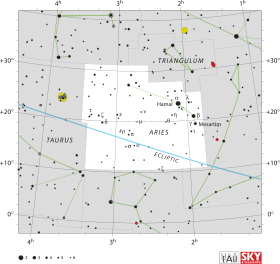Sigma Arietis ou σ Arietis est une étoile de la constellation du Bélier . Elle a une magnitude apparente de +5,52[ 2] œil nu dans un ciel nocturne de banlieue . Elle se situe à une distance d'environ 470 années-lumière parsecs Terre sur la base de la parallaxe et s'éloigne avec une vitesse radiale héliocentrique de +17 km/s [ 4] 20 novembre 1952 occultée par Jupiter [ 10]
Elle est une étoile bleu-blanc de la séquence principale avec un type spectral B7V[ 3] celui du Soleil [ 8] celle du Soleil [ 6] hélium et l'oxygène [ 6] espace interstellaire depuis son atmosphère extérieure avec une température effective brûlante de 13 121 K [ 6] étoile de type B . Elle tourne à une vitesse de rotation projetée de 165 km/s [ 6] association OB Cassiopée-Taureau qui partagent un mouvement commun dans la sphère céleste [ 11]
En 2016 , un compagnon stellaire a été signalé sur la base d'observations utilisant l'optique adaptative avec l'observatoire Gemini [ 7]
↑ a b c d et e
(en) A. G. A. Brown et al. Gaia collaboration), « Gaia Data Release 2 : Summary of the contents and survey propertiesAstronomy & Astrophysics vol. 616, août 2018 , article no A1 (DOI 10.1051/0004-6361/201833051 Bibcode 2018A&A...616A...1G arXiv 1804.09365
↑ a b c et d (en) D. L. Crawford, J. V. Barnes et J. C. Golson, « Four-color, H-beta, and UBV photometry for bright B-type stars in the northern hemisphere The Astronomical Journal vol. 76, 1971 , p. 1058 (DOI 10.1086/111220 Bibcode 1971AJ.....76.1058C ↑ a et b (en) Janet Rountree Lesh, « The Kinematics of the Gould Belt: an Expanding Group? The Astronomical Journal Supplement Series vol. 17, décembre 1968 , p. 371 (DOI 10.1086/190179 Bibcode 1968ApJS...17..371L ↑ a et b (en) R. Wielen et al. Sixth Catalogue of Fundamental Stars (FK6). Part I. Basic fundamental stars with direct solutions Veroeffentlichungen des Astronomischen Rechen-Instituts Heidelberg vol. 35, no 35, 1999 , p. 1 (Bibcode 1999VeARI..35....1W ↑ (en) E. Anderson et Ch. Francis, « XHIP: An extended hipparcos compilation Astronomy Letters vol. 38, no 5, 2012 , p. 331 (DOI 10.1134/S1063773712050015 Bibcode 2012AstL...38..331A arXiv 1108.4971 S2CID 119257644 ↑ a b c d e f g et h (en) J. Zorec, « Rotational velocities of A-type stars. IV. Evolution of rotational velocities Astronomy & Astrophysics vol. 537, janvier 2012 , article no A120 (DOI 10.1051/0004-6361/201117691 Bibcode 2012A&A...537A.120Z arXiv 1201.2052 S2CID 55586789 ↑ a b c d et e (en) Kevin Gullikson et al. The Close Companion Mass-ratio Distribution of Intermediate-mass Stars The Astronomical Journal vol. 152, no 2, août 2016 , p. 13 (DOI 10.3847/0004-6256/152/2/40 Bibcode 2016AJ....152...40G arXiv 1604.06456 S2CID 119179065 ↑ a et b (en) L. E. Pasinetti Fracassini et al. Catalogue of Apparent Diameters and Absolute Radii of Stars (CADARS) - Third edition - Comments and statistics Astronomy & Astrophysics vol. 367, no 2, février 2001 , p. 5211–524 (DOI 10.1051/0004-6361:20000451 Bibcode 2001A&A...367..521P arXiv astro-ph/0012289 S2CID 425754 ↑ (en) sig Ari sur la base de données Simbad Centre de données astronomiques de Strasbourg .↑ (en) Leon E. Salanave, « Occultation of Sigma ARIETIS by Jupiter Publications of the Astronomical Society of the Pacific vol. 65, no 382, février 1953 , p. 48 (DOI 10.1086/126529 Bibcode 1953PASP...65...48S S2CID 121458925 ↑ (en) P. T. de Zeeuw et al. A HIPPARCOS Census of the Nearby OB Associations The Astronomical Journal vol. 117, no 1, janvier 1999 , p. 354–399 (DOI 10.1086/300682 Bibcode 1999AJ....117..354D arXiv astro-ph/9809227 S2CID 16098861
Liens externes
Ressource relative à l'astronomie :
